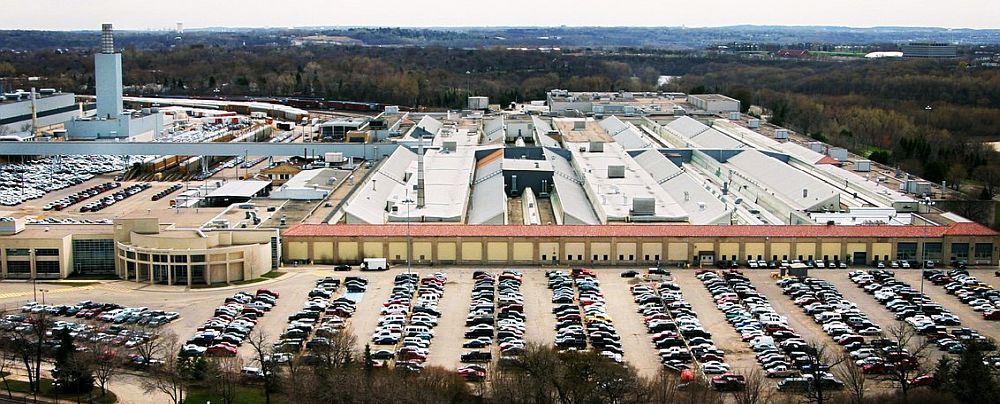Stream daylighting would reconnect community to Mississippi River: Redevelopment of historic Ford car assembly site in Saint Paul, Minnesota offers potential for “A 21st Century Community”
Note to Reader:
There once was a creek running through the St. Paul land where Henry Ford built his Twin Cities Assembly Plant. For decades, that water has run underground through a system of storm sewers that expelled it into the Mississippi River. The stream could see daylight again.
Ford, which began assembling cars in Minneapolis in 1912 and producing Model T’s at the site in 1925, closed the plant in December 2011 after nearly a century in operation.
A 2010 plan by the Capitol Region Watershed District explored bringing a number of St. Paul’s historic old streams and creeks back to the surface, including recreating the stream at the Ford site.

General concept plan for the former Ford Twin Cities auto plant in St. Paul, Minnesota
Restored stream to be central feature of Ford plant site’s redevelopment in St. Paul, Minnesota
As Ford’s former Twin Cities Assembly Plant is redeveloped in the coming years, a 21st Century Community will emerge on the 135 acres of land situated along the Mississippi River. The vision for the site is a connected, livable, mixed-use neighborhood that looks to the future with clean technologies and high quality design for energy, buildings and infrastructure.
When the site is redeveloped into 3,800 units of housing, they won’t be adding a golf course. There will be no corporate campus, 10-story buildings or major surface parking lots. And a Ford Museum isn’t part of their concept plans, either.
Instead, the plan is to install architecture reminiscent of Highland Village, a central water corridor that will be surrounded by four pedestrian-only and bicycle-only blocks on either side, 35 single-family homes along Mississippi River Boulevard and six-story and seven-story buildings closer to Ford Parkway.
Over the next decade, residents can also expect senior and affordable housing, a street grid that puts bicycles, pedestrians and drivers on a level playing field, more than 50 acres of public open space and 1,000 trees.
A 21st Century ‘Eco-Village’
The Ford plan reflects an ambitious vision that unites the techno-solutionist and urbanist wings of the sustainability movement—cutting-edge energy conservation and generation within a walkable urban village—with an additional emphasis on affordable housing and creative-class economic development.
What sets the Ford site project apart from most other brownfield redevelopments around the country is its resolve to become one of the first net-zero energy communities in America—all the power consumed would be generated from renewable sources on site.
One key feature of the plan is a district energy system, in which the heating, cooling, and hot water needs for a network of customers are served by piped-in hot and cold water.

The former Ford automobile plant
Vision for Reconnecting People to the Mississippi River
“Ford, which ceased operations in 2011, removed the underground storm sewer pipes that had been in place for more than 80 years. The site now drains into a temporary sedimentation basin,” wrote James Walsh in an article published in the St. Paul Star Tribune.
“For decades, heavy rains have sent muddy water gushing down the falls, carrying tons of sediment to the Mississippi. One benefit to an aboveground stream will be a more natural, sustained and gentle flow of water over the falls,” he reported.
 The project is exciting because it has multiple benefits. It will restore the creek and provide more consistent flow to Hidden Falls, said Wes Saunders-Pearce, St. Paul’s water resource coordinator. It will also reintroduce area residents to the Mississippi River.
The project is exciting because it has multiple benefits. It will restore the creek and provide more consistent flow to Hidden Falls, said Wes Saunders-Pearce, St. Paul’s water resource coordinator. It will also reintroduce area residents to the Mississippi River.
“We know we have a new neighborhood and how do we allow the existing neighbors and new neighbors to physically connect with the river as a resource?” he asked. “This is so powerful, because it’s also a way to have people reconnect with the urban ecosystem and the downstream river.”
To Learn More:
To read the complete story published in the St. Paul Star tribune, download a PDF copy of Restored stream to be central feature of Ford plant site’s redevelopment in St. Paul
For additional context, read The Bitter Battle to Turn an Old Factory Into a 21st Century ‘Eco-Village’

Restored stream to be central feature of Ford plant site’s redevelopment in St. Paul

